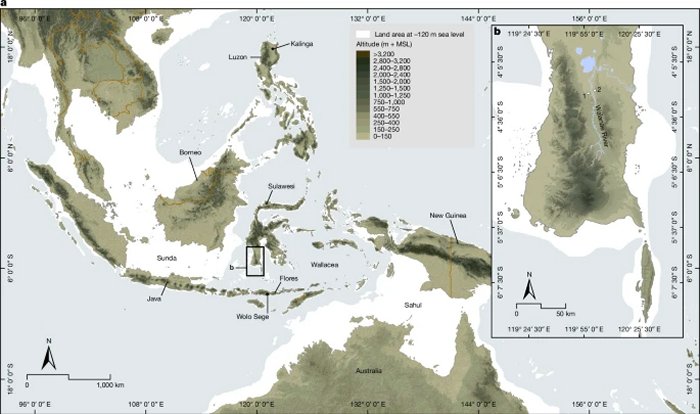Conny Waters – AncientPages.com – Recent findings by Griffith University researchers show that early hominins made a significant deep-sea crossing to reach the Indonesian island of Sulawesi much earlier than previously thought. This conclusion is based on the discovery of stone tools dating back at least 1.04 million years at the Early Pleistocene (or ‘Ice Age’) site of Calio.
Stone artefacts recovered from Early Pleistocene deposits at Calio. Source
Researchers led by Budianto Hakim from the National Research and Innovation Agency of Indonesia (BRIN) and Professor Adam Brumm from the Australian Research Centre for Human Evolution at Griffith University excavated a total of seven stone artefacts from the sedimentary layers of a sandstone outcrop in a modern corn field at the southern Sulawesi location.
During the Early Pleistocene, this area served as a hub for hominin activities, including tool-making and hunting, near a river channel. The Calio artifacts are composed of small, sharp-edged stone fragments known as flakes. These were created by early human tool-makers who struck them from larger pebbles, likely sourced from nearby riverbeds.
The team used palaeomagnetic dating of the sandstone and direct dating of an excavated pig fossil to establish that the artefacts are at least 1.04 million years old.
Earlier, the team had provided evidence of hominin presence in the Wallacea archipelago, indicating occupation from at least 1.02 million years ago, as evidenced by stone tools discovered at Wolo Sege on Flores Island, and approximately 194 thousand years ago at Talepu on Sulawesi.
The island of Luzon in the Philippines, to the north of Wallacea, had also yielded evidence of hominins from around 700,000 years ago.
“This discovery adds to our understanding of the movement of extinct humans across the Wallace Line, a transitional zone beyond which unique and often quite peculiar animal species evolved in isolation,” Professor Brumm said.

The location of Sulawesi within the Wallacean archipelago (Wallacea)—the zone of oceanic islands between the Asian and Australian continental regions (Sunda and Sahul, respectively). Source
“It’s a significant piece of the puzzle, but the Calio site has yet to yield any hominin fossils; so while we now know there were tool-makers on Sulawesi a million years ago, their identity remains a mystery.”
The initial discovery of Homo floresiensis, often referred to as the ‘hobbit,’ along with later findings of 700,000-year-old fossils of a similar small-bodied hominin on Flores, was led by Professor Brumm’s team.
These discoveries suggest that it might have been Homo erectus that crossed the challenging marine barrier from mainland Southeast Asia to settle on this small Wallacean island. Over hundreds of thousands of years, these hominins likely experienced island dwarfism.
Professor Brumm’s team’s recent discovery on Sulawesi presents a compelling reason to reconsider the fate of Homo erectus on this vast island, which is over 12 times larger than Flores. Sulawesi, as he describes it, is a “wild card”—a mini-continent with untapped potential for groundbreaking insights.
No doubt, researchers have now an intriguing possibility to explore further and uncover the mysteries that this unique land still holds.
According to Professor Brumm: “If hominins were cut off on this huge and ecologically rich island for a million years, would they have undergone the same evolutionary changes as the Flores hobbits? Or would something totally different have happened?”
Source – Griffith University via Eurekalert
Paper
Written by Conny Waters – AncientPages.com Staff Writer









